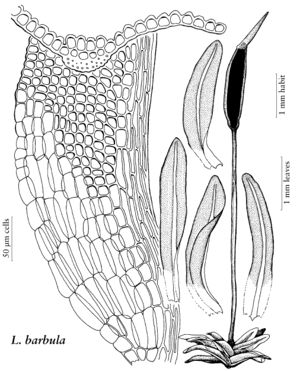Luisierella
Bull. Soc. Bot. France 83: 73, fig. 1. 1936 ,.
| Taxon | Illustrator ⠉ | |
|---|---|---|
 | Luisierella barbula | Patricia M. Eckel |
Plants scattered or gregarious, dull blackish green. Stems very short, 1.5–2 mm, hyalodermis absent, outer cortex undifferentiated, central strand absent; axillary hairs usually 5 cells in length, proximal cell yellowish. Leaves tubulose and contorted when dry, spreading and recurved from the insertion when moist, ligulate-lanceolate or oblong or long-elliptic, base weakly differentiated to elliptic, margins plane to erect-incurved, entire in proximal region, rounded-crenulate by bulging cells distally, lamina 1-stratose, apex rounded or rounded-obtuse to obtusely acute to occasionally cucullate; costa subpercurrent by 4–5 cells, adaxial outgrowths absent, covered ventrally with a layer of green, roundedquadrate to shortrectangular bulging cells continuous with those of the lamina but appearing elevated above them, in 4–5 rows; transverse-section elliptic to circular, adaxial epidermis strongly differentiated, adaxial stereid band absent, guide cells 2–4 (–5) in one row, hydroid strand absent, abaxial stereid band present, strong, semielliptic to semicircular in shape; basal-cells sharply differentiated in the lower 1/6 of the leaf, abruptly inflated but not bulging, smooth, rising higher along the margins and forming a V-shaped area, oblong-rectangular 2–3 (–4):1, thick-walled juxtacostally, becoming very thin and lax at the leaf margins; distal laminal cells roundedquadrate to shortrectangular, 1: 1 (–2), 1-stratose, essentially smooth, adaxial surface mammillose-bulging, abaxial surface plane, somewhat mammillose near the margins, the walls thickened, firm. Specialized asexual reproduction lacking. Sexual condition gynodioicous, fertile plants synoicous, plants with only archegonia not producing sporophytes; perichaetia terminal, interior perichaetial leaves much smaller than the cauline leaves. Seta 0.4–0.5 (–0.7) cm, rarely to 2 cm. Capsule stegocarpous, theca narrowly cylindric; annulus compound, large and strongly vesiculose in two rows, persistent; operculum narrowly high-conic; peristome teeth sixteen, linear or narrowly lanceolate, variable in development: absent, rudimentary or to 500 µm, erect. Calyptra cucullate. Spores 8–9 µm. KOH laminal color reaction negative, light yellow to orange.
Distribution
se United States, Mexico, West Indies, Central America, South America, Asia
Discussion
Species 1.
Luisierella is characterized by plants blackish, minute, with ligulate leaves tubulose when dry, laminal cells adaxially mammillose, abaxially plane, adaxial costal surface with bulging rounded cells, and adaxial stereid band absent. The abruptly thin-walled hyaline basal cells extending up the leaf margin in a V shape is distinctive; it is this latter character that quickly distinguishes this genus from similar genera: Gyroweisia, Hyophila, and Plaubelia. Luisierella bears little relation to the genus Tortella, which is also characterized by differentiated basal cells that extend higher on the leaf margin than along the costa. Luisierella has been suggested to be ancestrally related to the genus Quaesticula R. H. Zander (R. H. Zander 1993) through reduction of gametophyte characters and elaboration of reproductive ones.